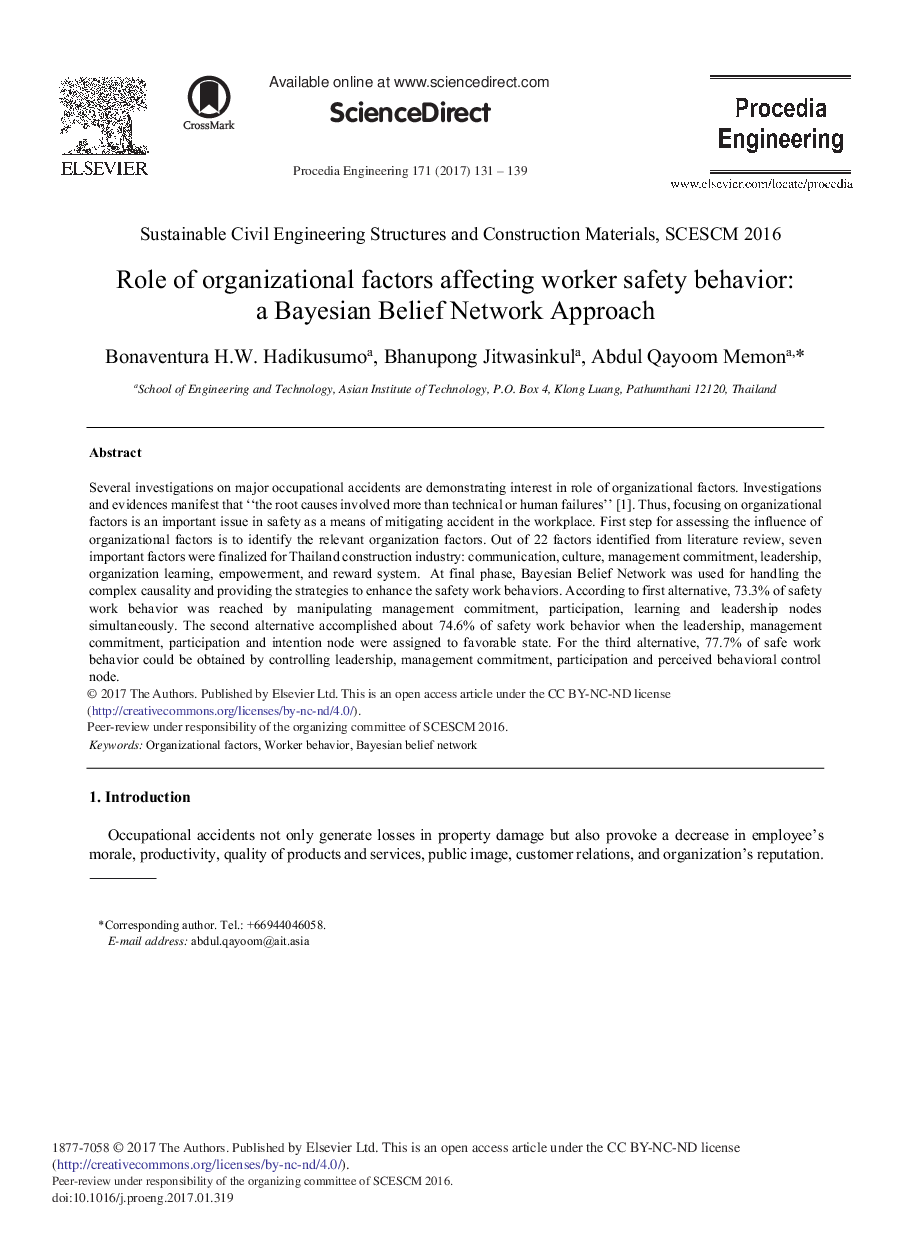| کد مقاله | کد نشریه | سال انتشار | مقاله انگلیسی | نسخه تمام متن |
|---|---|---|---|---|
| 5028543 | 1470655 | 2017 | 9 صفحه PDF | دانلود رایگان |
عنوان انگلیسی مقاله ISI
Role of Organizational Factors Affecting Worker Safety Behavior: A Bayesian Belief Network Approach
ترجمه فارسی عنوان
نقش عوامل فاکتورهای موثر بر رفتار ایمنی کارکنان: یک رویکرد شبکه اعتقاد بیزی
دانلود مقاله + سفارش ترجمه
دانلود مقاله ISI انگلیسی
رایگان برای ایرانیان
کلمات کلیدی
عوامل سازمانی، رفتار کارگر، شبکه اعتقادات بیزی
ترجمه چکیده
تحقیقات متعدد در حوادث شغلی عمده نشان دهنده علاقه به نقش عوامل سازمانی است. تحقیقات و شواهد نشان می دهد که یک علت ریشه درگیر بیش از نقص فنی یا انسانی است؟ [1] بنابراین تمرکز بر فاکتورهای سازمانی یک مسئله مهم در ایمنی است به عنوان وسیله ای برای کاهش ریسک در محل کار. اولین گام برای ارزیابی تأثیر عوامل سازمانی، شناسایی عوامل سازمانی مربوطه است. از 22 عامل شناسایی شده از بررسی ادبیات، هفت عامل مهم برای صنعت ساخت و ساز تایلند نهایی شد: ارتباطات، فرهنگ، تعهد مدیریت، رهبری، یادگیری سازمانی، توانمند سازی، و سیستم پاداش. در مرحله نهایی، شبکه اعتقاد بیزی برای مدیریت علیت پیچیده و ارائه استراتژی برای افزایش رفتارهای ایمنی استفاده شد. با توجه به جایگزین اول، 73.3٪ رفتار کار ایمنی با دستکاری تعهد مدیریت، مشارکت، یادگیری و گره های رهبری به طور همزمان رسید. دومین جایگزین در حدود 6/74 درصد از رفتارهای ایمنی کار را انجام داد وقتی که رهبری، تعهد مدیریت، مشارکت و قصد گره به دولت مطلوب اختصاص یافت. برای جایگزین سوم، 77.7٪ از رفتار کار ایمن را می توان با کنترل رهبری، تعهد مدیریت، مشارکت و گره های کنترل درک شده به دست آورد.
موضوعات مرتبط
مهندسی و علوم پایه
سایر رشته های مهندسی
مهندسی (عمومی)
چکیده انگلیسی
Several investigations on major occupational accidents are demonstrating interest in role of organizational factors. Investigations and evidences manifest that “the root causes involved more than technical or human failures” [1]. Thus, focusing on organizational factors is an important issue in safety as a means of mitigating accident in the workplace. First step for assessing the influence of organizational factors is to identify the relevant organization factors. Out of 22 factors identified from literature review, seven important factors were finalized for Thailand construction industry: communication, culture, management commitment, leadership, organization learning, empowerment, and reward system. At final phase, Bayesian Belief Network was used for handling the complex causality and providing the strategies to enhance the safety work behaviors. According to first alternative, 73.3% of safety work behavior was reached by manipulating management commitment, participation, learning and leadership nodes simultaneously. The second alternative accomplished about 74.6% of safety work behavior when the leadership, management commitment, participation and intention node were assigned to favorable state. For the third alternative, 77.7% of safe work behavior could be obtained by controlling leadership, management commitment, participation and perceived behavioral control node.
ناشر
Database: Elsevier - ScienceDirect (ساینس دایرکت)
Journal: Procedia Engineering - Volume 171, 2017, Pages 131-139
Journal: Procedia Engineering - Volume 171, 2017, Pages 131-139
نویسندگان
Bonaventura H.W. Hadikusumo, Bhanupong Jitwasinkul, Abdul Qayoom Memon,
